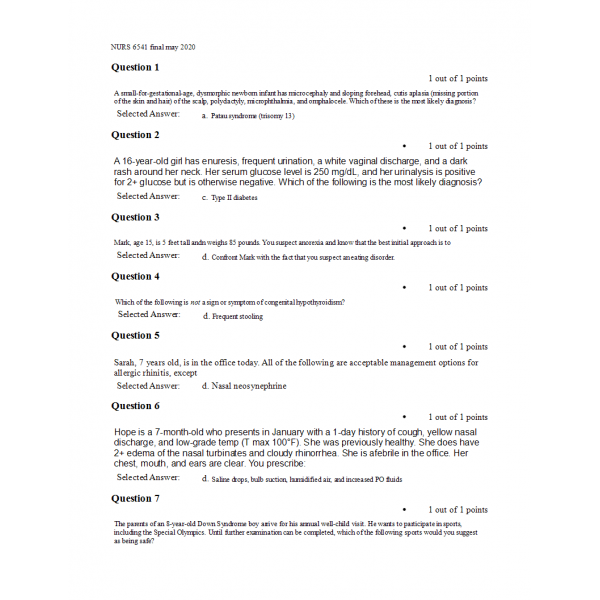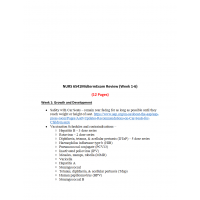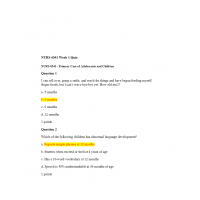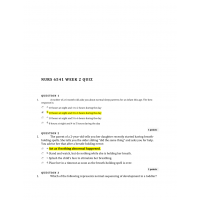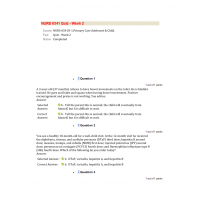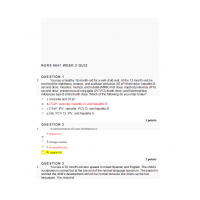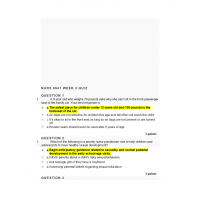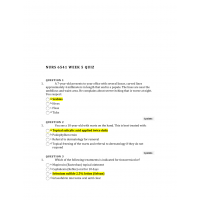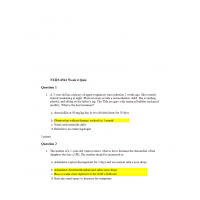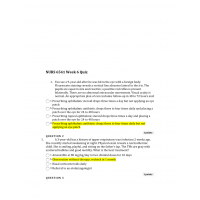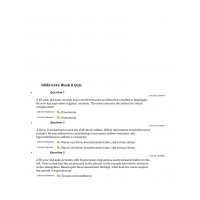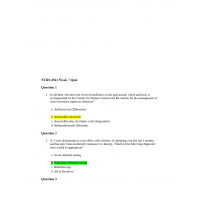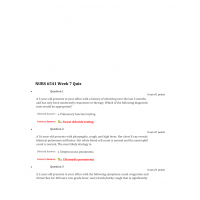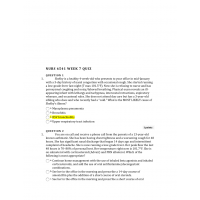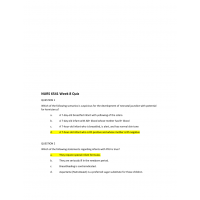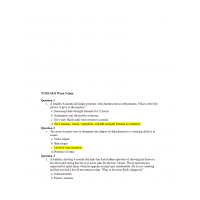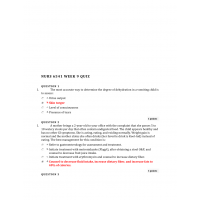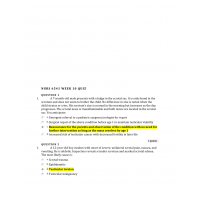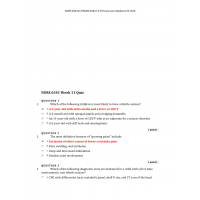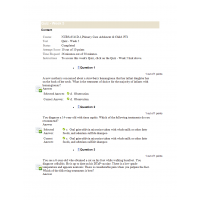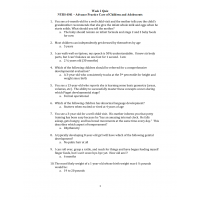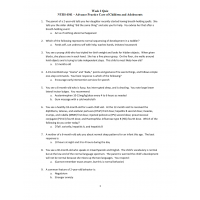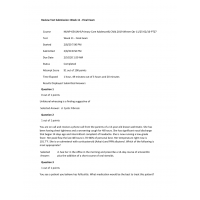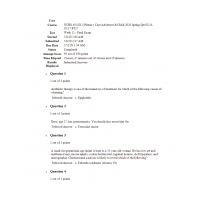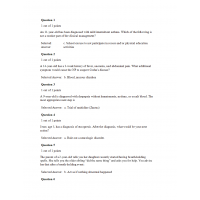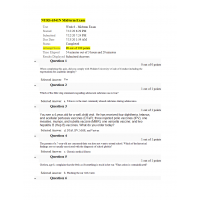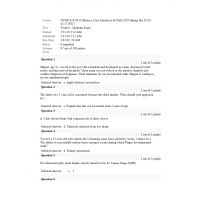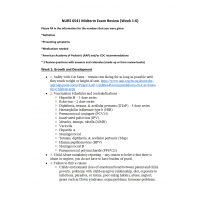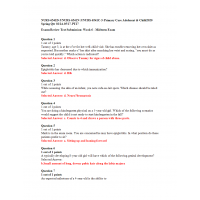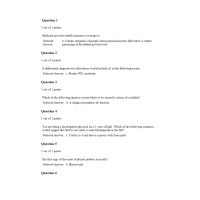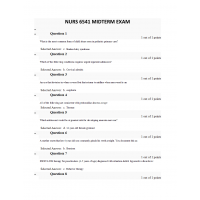NURS 6541 Final Exam
1. A small-for-gestational-age, dysmorphic newborn infant has microcephaly and sloping forehead, cutis aplasia (missing portion of the skin and hair) of the scalp, polydactyly, microphthalmia, and omphalocele. Which of these is the most likely diagnosis?
2. A 16-year-old girl has enuresis, frequent urination, a white vaginal discharge, and a dark rash around her neck. Her serum glucose level is 250 mg/dL, and her urinalysis is positive for 2+ glucose but is otherwise negative. Which of the following is the most likely diagnosis?
3. Mark, age 15, is 5 feet tall andn weighs 85 pounds. You suspect anorexia and know that the best initial approach is to
4. Which of the following is not a sign or symptom of congenital hypothyroidism?
5. While doing a 5-year-old well child exam, you notice two small patches of hair loss. Broken hair is present, as is erythema and scaling. On the basis of this information, which of these is the likely diagnosis?
6. Hope is a 7-month-old who presents in January with a 1-day history of cough, yellow nasal discharge, and low-grade temp (T max 100°F). She was previously healthy. She does have 2+ edema of the nasal turbinates and cloudy rhinorrhea. She is afebrile in the office. Her chest, mouth, and ears are clear. You prescribe:
7. The parents of an 8-year-old Down Syndrome boy arrive for his annual well-child visit. He wants to participate in sports, including the Special Olympics. Until further examination can be completed, which of the following sports would you suggest as being safe?
8. Jason, age 14, appears with tender discoid breast tissue enlargement (2-3 cm in diameter) beneath the areola. Your next action would be to
9. You see a 7-year-old boy a day after he was bitten by his pet dog. According to the mother, the dog bit the child after he snuck up on the dog and grabbed his tail. The dog has had all its vaccinations, including rabies. The child has had no fever, has full movement of the injured limb, and has no sign of neurologic or vascular injury. The wound is on the child’s forearm, is not deep, and is not bleeding, but has developed about 2 cm of erythema surrounding the site. Which of the following is the most appropriate treatment?
10. A head injury in which bruising or tearing of the cerebral structures occurs is a
11. A 14-year-old has a 3-week history of fever, anorexia, and abdominal pain. What additional symptom would cause the NP to suspect Crohn's disease?
12. Which of the following should be done annually after 1 year of age in a child with Down syndrome?
13. A previously healthy male has a 3-month history of increasing headaches, blurred vision, and personality changes. Previously he admitted to marijuana experimentation more than 1 year ago. On examination he is a healthy, athletic-appearing 17-year-old with decreased extraocular range of motion and left eye visual acuity. Which of the following is the best next step in his management?
14. Kelly, your 11-year-old well visit patient, presents to the office with weight loss, polyuria, and polydipsia. Which of the following do you need to rule out?
15. A 3-week old presents to the office in January with a 1-week history of nasal congestion and occastional cough. On the night prior to the visit in infant developed a fever 102ºF rectally, was difficult to breastfeed, and had paroxysmal coughing and noisy, labored breathing. On exam, you note an ill-appearing infant who is lethergic with wheezing, tachypnea, and intercostal retractions. The infant is home with the mom at this time; however, has a sibling who is 4-years-old and is in daycare and recently had cold symptoms. If the patient has been diagnosed with RSV bronchiolitis, which of the following would be the treatment of choice?
16. Chest pain in young children is usually
17. Maddie, age 2, had a complete blood count (CBC) drawn at her last visit. It indicates that she has a microcytic hypochromic anemia. What should you do now at this visit?
18. Most children with Duchenne muscular dystrophy become wheelchair dependent by what age?
19. The following clinical description best matches which genetic disorder? A tall, thin 14-year-old boy has no signs of puberty. He was delayed in his speech development and always has done less well in school than his siblings. He is shy, and teachers report his activity is immature. Physical examination reveals breast development, and long limbs with a decreased upper segment/lower segment ration. He has small testes and phallus.
20. Of the following patients, which child should not receive a tuberculin skin test?
21. A 10-year-old male presents with a fever of 102ºF and complaints of leg pains. His mother reports that he had an upper respiratory infecion with a sore throat about 2 weeks ago. No treatment was needed. On examination, he has tender and swollen knees bilaterally. His heart rate is 125 bpm and a blowing systolic murmur is heard at the apex. No murmur was noted at in the chart. The mostly diagnosis is:
22. When a neonate is initially protected against measles, mumps, and rubella because the mother is immune, this is an example of which type of immunity?
23. Sarah, age 13, is markedly obese and has a poor self-image. How do you differentiate between compulsive eating and bulemia?
24. Seborrhea dermatitis is common for both infants and adolescents. Which is not correct for this condition?
25. Which chromosomal abnormality is associated with short stature in girls?
26. You see a patient you believe has folliculitis. What medication would be the best to treat this patient? The patient has no allergies.
27. Antibiotic therapy is one of the mainstays of treatment for which of the following causes of wheezing?
28. Which of the following symptoms are most suggestive of pneumonia in a young child?
29. An 11-year-old has been diagnosed with mild intermittent asthma. Which of the following is not a routine part of the clinical management?
30. Generalized absence seizures usually occur in which age group?
31. Which test is routinely recommended for a preparticipation sports physical?
32. A healthy, thriving 4-year-old male has had sudden episodes of drawing his knees to his chest and crying like he is in acute pain for the last 5 hours. These episodes are separated by quiet times when he appears normal and comfortable. He is not vomiting and has not had a bowel movement today. What is the most likely diagnosis.
33. A 15-day-old infant has respiratory distress. A quick observation suggests she has slight cyanosis, hepatosplenomegaly, and features consistent with Down Syndrome. The cardiac examination demonstrates a loud first heart sound, a low-pitched, mid-diastolic murmur at the lower left sternal border, and a harsh apical holosystolic murmur in the mitral area. Which of the following cardiac conditions most likely explains her heart findings?
34. An ex-preemie with bronchopulmonary dysplasia has been discharged to home from the NICU. One potential problem area that requires close monitoring is
35. A 16-year-old presents with pharyngitis, cough, and high fever. Her chest x-ray reveals bilateral pulmonary infiltrates. Her white blood cell count is normal and the neutrophil count is normal. The most likely etiology is
36. Which of the following vaccines provides protection against a common type of sepsis/meningitis?
37. A mother brings a 2-year-old to your office with the complaint that she passes 5 to 10 watery stools per day that often contain undigested food. The child appears healthy and has no other GI symptoms. She is acting, eating, and voiding normally. Weight gain is normal and the mother states she often drinks (her favorite drink is Kool-Aid) instead of eating. The best management for this condition is:
38. Six months after being diagnosed with what appears to be insulin-dependent diabetes, the 5-year-old in the case presentation has a significant decrease in his insulin requirement. Which of the following is the most likely explanation?
39. Grace, age 15, has been diagnosed with acne. Which of the following is not true with this condition?
40. All of the following is treatment for a child with phimosis except
41. Primary dysmenorrhea is due to
42. Children in child care facilities are at greater risk of being exposed to which of the following infections?
43. A 14-month-old child has lower extremity bowing, a waddling gait, genu varum, and is at the 5th percentile for height. Laboratory data include low-normal serum calcium, moderately low serum phosphate, and elevated serum alkaline phosphatase levels, hyperphosphaturia, and normal parathyroid levels. Which of the following is the most likely diagnosis?
44. A child has developed her second perirectal abscess in 6 months. She should be evaluated for which of the following conditions?
45. The classic radiographic finding of croup is
46. What is the primary treatment for testicular torsion?
47. You see a 7-year-old with a positive stool culture for Salmonella enteriditis. The appropriate therapy for a non-dehydrated child is
48. Riley, a 12-year-old girl, has scaly, hyperpigmented lesions in a "Christmas tree" distribution. It is predominantly on her trunk. One lesion is on her buttock that is larger than the other, at about 4 cm in diameter. What is your diagnosis?
49. You are on call and receive a phone call from the parents of a 13-year-old known asthmatic. She has been having chest tightness and a worsening cough for 48 hours. She has significant nasal discharge that began 14 days ago and intermittent complaint of headache. She is now running a low-grade fever. Her peak flow the last 48 hours is 70–80% of personal best. Her temperature right now is 101.7°F. She is on salmeterol with corticosteroid (Advair) and PRN albuterol. Which of the following is most appropriate?
50. Which of the following therapeutic options is common for the treatment of both bee stings and bite wounds?
51. A common presenting symptom of inflammatory bowel disease is
52. Newborn R.T. has a vascular lesion that will not fade as she gets older. What is your diagnosis?
53. Ana is a 14-year-old female and has not yet started her menstrual cycle. The history is noncontributory and the physical is normal. Mom started her menstrual cycle at 14-years of age. Ana's breast development and pubic hair began about a year ago. Mom is very concerned. The most appropriate initial step would be to
54. The diet of a 3-year-old with cystic fibrosis should be supplemented with which of the following?
55. Which of the following objective data are associated with significantly better long-term outcomes in children born with open spina bifida?
56. Individuals with chronic adrenal insufficiency often have
57. A healthy 8-month-old infant presents with diarrhea but no dehydration. What is the best advice to give to the parents?
58. An essential test in the evaluation of a 2-year-old being managed for Kawasaki disease is
59. In mild to moderate attacks of acute asthma, Albuterol should be given every 4-6 hours prn and routine medication should be
60. Which fo the following foods would be most appropriate for a child with celiac disease?
61. John is 4 years old and in today for a well child visit. He is due for his 4-year-old immunizations. He was recently diagnosed with ALL and is being treated with chemotherapy and radiation. Which statement is true about immunizations during treatments during childhood cancer?
62. The most useful test for evaluation of suspected acute rheumatic fever is
63. A 15-year-old girl has a 1-month history of urinary frequency without dysuria and recent onset of an itchy rash beneath both breasts. She has been gaining weight over the past year and regularly complains of fatigue. She is afebrile, with a weight greater than the 99th percentile and has an erythematous, macular rash beneath both breasts characterized by satellite lesions. Urinalysis is significant for 2+ glucosuria but no pyuria. Which of the following is the most likely diagnosis?
64. Tommy has bloody diarrhea. His family eats fast-food four to five times each week. Which organism may have caused the diarrhea?
65. A 6-year-old male is brought in for evaluation of a painful hip. He has been limping and not wanting to walk for the past 2 days. He has no obvious injury. He feels a little better if he is given ibuprofen. He has not had a fever and does not have any other current symptoms, although he had "the flu" last week. On examination, his vital signs are normal. His right hip has some pain with internal rotation. He walks with a pronounced limp. Which of the following statements is most accurate?
66. Which of the following conditions is most responsible for developmental delays in children?
67. Which of the following is not a feature of DiGeorge syndrome?
68. The peak incidence for adolescent gynecomastia occurs at age
69. The most common trigger for an acute asthma episode in the very young child is
70. The following clinical description best matches which genetic disorder? A 15-year-old girl with primary amenorrhea is noted to be well below the 5th percentile for height. She has hypertension, a low posterior hairline, prominent and low-set ears, and excessive nuchal skin.
71. Kawasaki disease is most common in
72. What does a low level of thyroid stimulating hormone (TSH) indicate?
73. John, age 12, injured his spinal cord by diving into a shallow lake. He is in a wheelchair but can self-transfer. He can use his shoulder and extend his wrist, but has no finger control. At what level of the spinal cord was the damage?
74. Drew is a 6-month-old with newly diagnosed sickle cell disease. His mother brings him to the office for a well-baby visit. Which of the following should you do on this visit?
75. The most common central nervous system side effect of mumps in children is
76. Whitney is a 2-year-old female with dysuria. She has a fever of 102.4 and is nontoxic. She has no prior history of UTI. Urine dipstick reveals 1+ leukocyte esterase, 2+ nitrates, 1+ non-hemolyzed blood, pH of 6.0, and specific gravity 1.025. Her vulvovaginal area is slightly red with no discharge. Which of the following treatments is recommended.
77. One of the most appropriate agents used to treat influenza A is
78. Robert, your 15-year-old male patient, is here today for a well visit. He is tall in stature and has increased arm span, laxity of joints, pectus excavatum, and an abnormal echocardiogram. Which of the following diagnosis would you suspect Robert as having?
79. A 7-week-old male with three episodes of severe abdominal pain and vomiting in the last month, previously diagnosed with failure to thrive. Which of the following is the most likely etiology?
80. Which of the following is a characteristic physical sign of fragile X syndrome in adolescent males?
81. A small-for-gestational-age infant is born to a 35-year-old woman. He has low-set and malformed ears, microcephaly, rocker-bottom feet, inguinal hernias, cleft lip/palate, and micrognathia. Chromosomal analysis is likely to reveal which of the following?
82. Sam is a healthy 17-year-old student. He is thinking about having sex and asks for more information about condoms. You give him all of the following information except
83. During the 2-year-old well-child visit, the child's mother shows you a picture from the birthday party. You notice only one eye has a red reflex on the picture. When you do the exam, in the right eye, you notice leukocoria. What is your diagnosis?
84. Which of the following is true regarding the diagnosis of epiglottitis?
85. Dave, age 17, has gynecomastia. You should also assess him for
86. In children who have not received antibiotics in the past month, which antibiotic is recommended by the Centers for Disease Control and Prevention for the management of acute bacterial respiratory infection?
87. A 6-week-old boy, born by vaginal delivery after an uncomplicated term gestation, has experienced cough and “fast breathing” for 2 days. His mother relates that he has a 1-week history of nasal congestion and watery eye discharge, but no fever or change in appetite. He has a temperature of 99.4°F and a respiratory rate of 44 breaths/min. He has nasal congestion, clear rhinorrhea, erythematous conjunctivae bilaterally, and watery, right eye discharge. His lungs demonstrate scattered crackles without wheezes. Which of the following is the most likely pathogen?
88. Screening infants for anemia should occur at what age?
89. Tracy, the mother of a 2-year-old, is concerned because her daughter walks on her toes all the time. What do you tell her?
90. Pinworms can cause which of the following?
91. Which of the following is important to determine in the recent history of a child with suspected Clostridium difficile infection?
92. The following clinical description best matches which genetic disorder? An institutionalized male juvenile delinquent upon close examination has severe nodulocystic acne, mild pectus excavatum, large teeth, prominent glabella, and relatively long face and fingers. His family says he has poor fine motor skills (such as penmanship), an explosive temper, and a low-normal IQ.
93. You are seeing a patient you think may have IBD. Which of the following tests would not be helpful?
94. What does shift to the left mean in a white blood count?
95. A 6-year-old boy is left alone for 10 hours, now with hematemesis and pneumomediastinum on chest x-ray. Which of the following is the most likely etiology?
96. During a track and field meet, a 16-year-old male pole-vaulter falls to the ground screaming in pain. He complains of intense pain in his right scrotum. He vomits twice while waiting for the ambulance. He most likely has
97. A 12-year-old girl was brought to the emergency department because of severe sore throat, muffled voice, drooling, and fatigue. She had been sick for the past 3 days and is unable to eat because of painful swallowing. The parents deny any history of recurrent pharyngitis. The patient still managed to open her mouth and you were able to see an abscess at the upper pole of the right tonsil with deviation of the uvula toward the midline. Examination of the neck reveals enlarged and tender lymph nodes. Which of the following is the most appropriate management?
98. Prophylactic penicillin should be started in children with sickle cell anemia by
99. An 18-month-old African American girl is brought to your office because she has been crying and stopped walking today. She will crawl, however. Her mom denies any injury to the child. On examination, she is crying but consolable in her mother’s arms. She has bruising and swelling just proximal to the left ankle. An x-ray reveals a spiral fracture of the tibia. At this time, you advise the mother that:
100. Mrs. Bay is upset. She is convinced something is seriously wrong with her son. He is a 2-month-old and frequently vomits after feeding. Which of the following is most suggestive of GERD (gastroesophageal reflux disease)?
| Institution & Term/Date | |
| Term/Date | Walden University |
NURS 6541N Final Exam 2 (100 out of 100)
- Product Code: 2020
- Availability: In Stock
-
$45.00
Related Products
NURS 6541D Week 5 Quiz
$9.99
NRNP 6541N Midterm Exam 1
$30.00
Tags: NURS 6541

